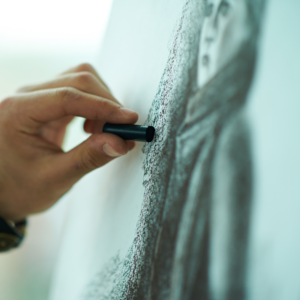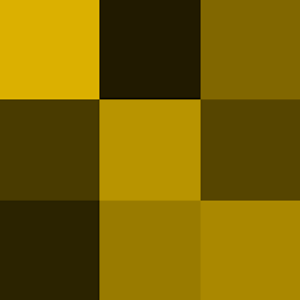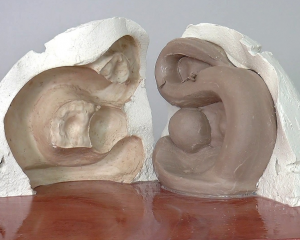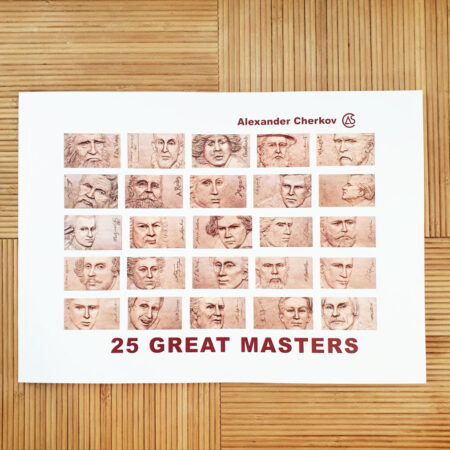autobiography. Marc Chagall (1887-1985), was born in the village of Lyozno, near Vitebsk, in Belarus. The eldest son of nine children born to Hatzkel Chagall and Paige-Ita, a Hasidic Jewish family. In 1906, Chagall began studying painting in Vitebsk and continued for three years in Petersburg. From 1910 he stayed in Paris for four years and returned to Wittesbeck via Berlin, where he had a solo exhibition (Wolf, 2019). In 1915 Chagall married Bella Rosenfeld and they moved to Petersburg until 1923, when he moved with his wife and daughter Ida to France. During this period in Russia, Chagall was the supervisor of art in Vitebsk, founded and managed an art school, and in 1920 he retired from his position and painted on the walls and ceiling of the Russian theater and prepared sets for performances there (Mullen, 1969). In 1922 he wrote his autobiography "My Life" (Chagall, 1951).
In France, he illustrated books and made engravings for the Bible. In 1941, Chagall left France because of the war and immigrated to New York. In '44 his wife Bella died. In '47 he began color lithography, and a year later he returned to Paris. In '50 he began pottery , and in '51 he created his first sculptures. In '52 he married Valentin (Va) Brodsky, and continued to paint, but in a more lyrical and abstract style, with more melancholic colors and themes. Chagall achieved great achievements in his art in his lifetime. In '57 he began mosaic works , and in '60 he began stained glass windows for Metz and Jerusalem. In '63 he painted the ceiling of the Opera House in Paris, and in '66 he painted the walls of the Arts Center in New York (Mulan, 1969).
Although Chagall saw his painting as oriental, which does not belong to a certain movement in art (Mulan, 1969), it is possible to find in his artistic style combinations of the visual elements from the style of Cubism, Impressionism, Fauvism, Primitivism, Symbolism and Surrealism. Chagall created in a wide range of materials, oil painting, gouache, water colors, ceramic sculpture, wall paintings and stained glass works (Mulan, 1969; Wolf, 2019). Chagall observed the world in what he himself called 'the light of freedom', which can be visualized in the colors of love. According to him, it is possible to transform everything in painting if you speak the language of love (Sherway Academy Arts & Sciences, 2017). Chagall used two words from the living world that were the way for him to describe his works: "'embroidery' as a term for everything that can make the painting like living flesh in terms of color, light and material. 'Chemistry' refers to the same matter, but not to the finished collection of the tiny structures but to the process their creation" (Mulan, 1969, p. 25). That is, Chagall treated the creative process as an integral part of the artistic product. Chagall expressed a wide variety of subjects in his works, he painted what he saw and what he dreamed (Chagall, 1951), but the subject of marriage never left his area of concern.
Analysis of a selected body of works. Among the many works of the artist, we chose ten works, among which I found a connection and a sequence that could express the story of Chagall's life, in the aspect of his concept of couplehood. According to the phenomenological approach, through the investigation of the "is" in the present, it is possible to conceptualize the characteristics of the work that are intertwined in the way it was created, to the structure and form of the subjective experience, thereby shedding light on the creator's life story (Betansky, 1995). From the phenomenological observation of the selected body of works, I will combine the way the artist relates to his work, together with a connection to his background.
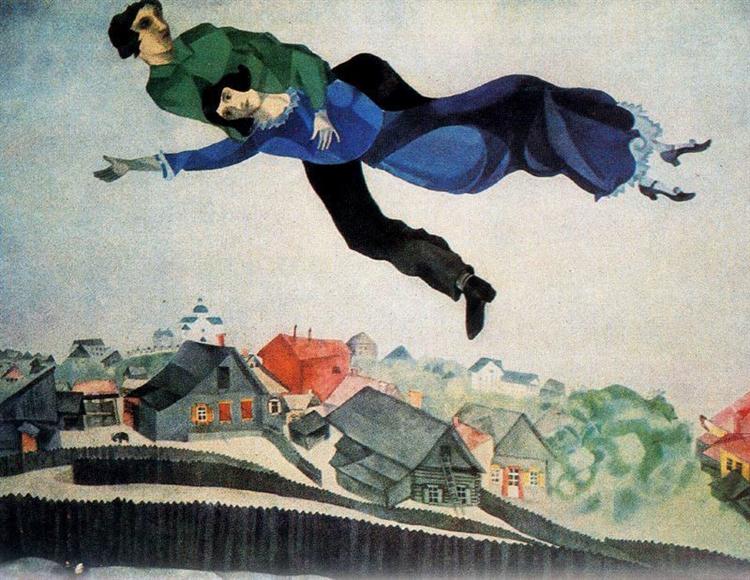
Chagall created rich colors using a limited color palette in most of his works. Among his first paintings one can find the predominance of the color green and its complementary color red. The complementary colors reinforce each other and create balance through their location in the compositional space. For example, in the painting "The Promenade" (1918), the color of the dress of the flying figure is associated with the house in the green cityscape, and finds a balance with the spots of red color in the lower left part of the composition (painting 1). Chagall wrote about his fondness for the color purple (1951, p. 39), in this color he describes Bella's dress, as it can be identified according to his writing: "She flies from a distance across my fabric" (1951, p. 74). Likewise, the same balance was created in the use of these colors in the painting "Window in the Country" (1915); The two spots of red color at the bottom of the composition, in relation to the shadow of the faces of the figures on the lower left, which consists of mixing these two colors, in front of the green landscape that occupies most of the artwork's substrate (drawing 2).

Oil on Canvas
The turning point is noticeable in his early paintings, but it is hard to find. As for example in painting 2, Chagall applies a combined perspective with one vanishing point above and one to the left, and both are located far outside the borders of the composition. This presentation of the space conveys a feeling of optimism and that the world is open to both of them, as is also felt through the description of the raised curtain in this painting, together with the minimalism of the window frame that brings the view into their personal space, and the unity of the characters with the background in color. His paintings depict the human connection as a part, or continuation, of nature itself. A description that expresses his perception of the importance of the artist being in harmony with nature (Mulan, 1969, p. 27).
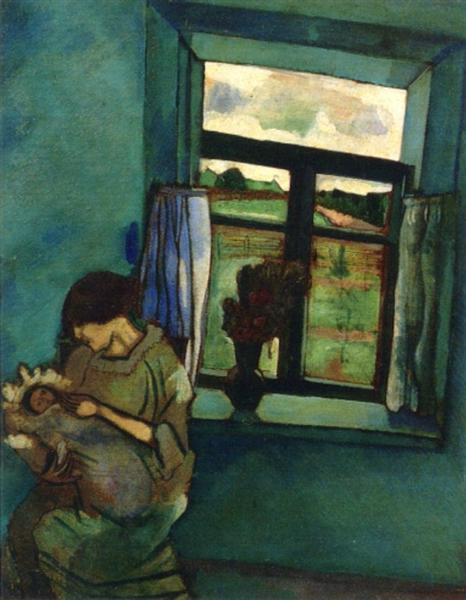
Oil on Canvas
In most of his paintings, Chagall presents his self-portrait. But in the painting "Bella and Ida by the Window" (1916)", Chagall does not appear, but only Bella and Ida their daughter. Compared to other paintings of the same period, this painting is dark and empty of objects for the most part. The upper axis of the window is shown diagonally in relation to the lower axis and the horizontal axis of the curtain rack , which creates a feeling of dizziness, which finds a balance with the volume of the figures, gathered to the left in Bella's gaze towards Ida, as she looks into the space of the room. In this way of organizing the composition, along with hiding the point of departure in the vertical axis of the window, the lack of control and certainty that the creator felt (drawing 3). Chagall wrote about the difficulty he felt in the birth of his house; "Shame! I was hoping for a son, and here is a daughter. And at night, shrieks and screams for nothing. I threw you angrily on the bed. that you don't eat babies' screams. Terrible and horrible!" (1951, p. 92)
In the sequence of the series of paintings of those years, a year later, Chagall presents Bella, in the painting "Bella with White Collar" (1917), as 'larger than life' in light of the size of her figure, which reinforces her importance. With Bella's hand pointing, Chagall presents himself together with Ida, as little ones at the bottom of the composition, against a blue and white tonal base similar to the background around Bella.
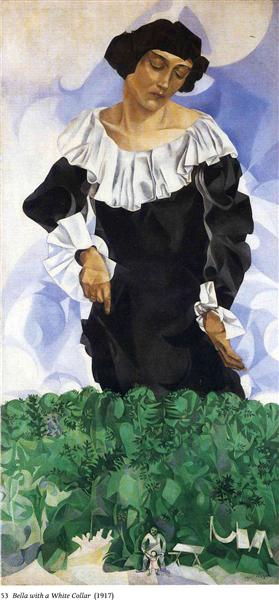
Oil on Canvas
His figure's head is painted green, as a continuation of the green nature above it, while Ida's dress is painted red, as a point that creates the whole (drawing 4). It seems that the description of nature, in Chagall, is often expressed through the concrete use of color, and the expression of relationships through the abstract use of color.
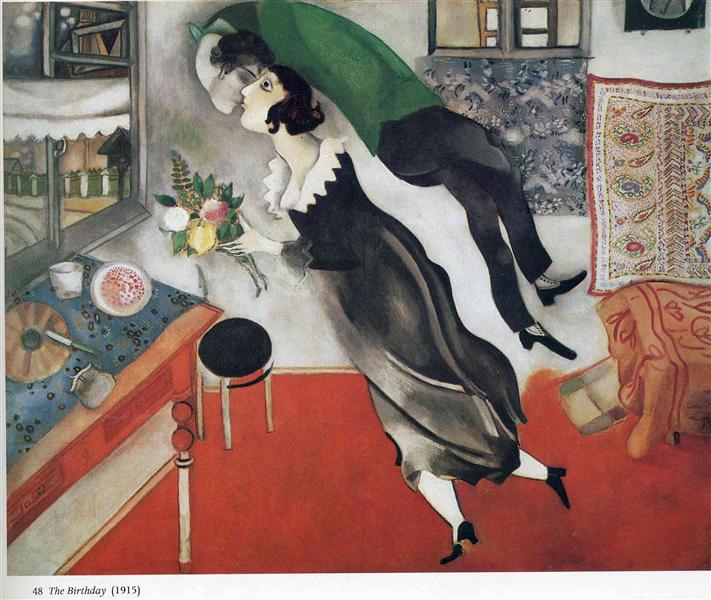
Chagall also described the figure of Bella as large in the earlier painting "The Birthday" (1915), when he himself is depicted floating, in a flexible and flowing body position, kissing Bella, who gives him the feeling of security and lifts him up, against the background of the blurring of the horizontal line of the corner of the room below him , next to the stability of the clear line below it (Figure 5). As a continuation of the theme of flight, in painting 1, Bella is seen calling him to fly, with both depicted in the foreground against a city background with geometric shapes.
Chagall combines a rich variety of lines in the composition, some that are clear and sharp and some that are blurred and spread out, some are continuous and some are fragmented, some are flowing and some are sharp geometric. Although the variety of lines can be found in every work, his early works are characterized by geometric shapes, clear and angular lines, with the color defining the shape. For example, the description of the trees in drawing 2, and the elements of the whole work in drawing 3. The use of rounded lines together with angular ones, on the one hand, create a feeling of movement, and on the other hand, impose static and stagnation. As can be seen in the description of the curtain in the center of the composition in painting 2. This manner gives the feeling that Chagall is expressing the desire to leave time in its place, and the mere commemoration of this moment, alongside Bella, can testify to its importance in Chagall's world.
Over the years, Chagall renounced the Cubist aesthetic and reflected on the reality of the pictorial space which is not the same as visible reality (Mulan, 1969). Chagall spoke of another, more abstract dimension of being free and liberated, "Art seems to me to be a state of mind more than anything else" (Mulan, 1969, p. 50).
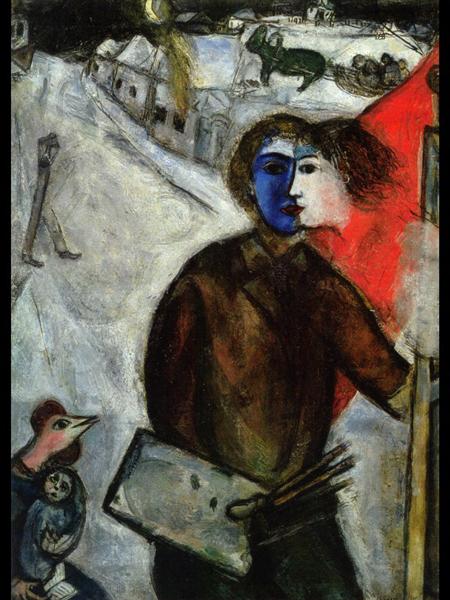
Against the backdrop of the move to Paris and later to New York due to the escalation of the war, his later paintings become darker with many layers of color and a more flowing and expressive line. It seems that he paints the canvas black, and from it brings out colored images, scattered in space, without perspective, which gives the feeling of a dream wrapped in the memories of his life, as he also said; "My life is all identified with my creativity" (Mulan, 1969, p. 34). For example, the black background in the painting "Hour between Wolf and Dog (Between Darkness and Light)" (1938-43), from which emerges an image of a snowy street with a sleigh drawn by a horse, with the frame remaining black, which can express his longing and memories of Russia (painting 6) .
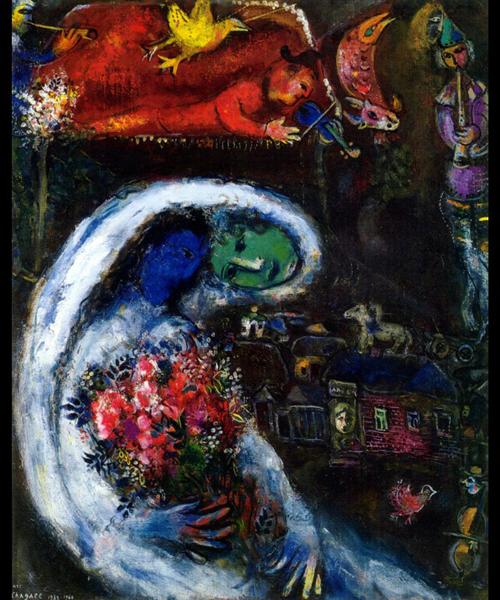
Oil on Canvas
In the painting "Bride with Blue Face", the elasticity of the body position of the male figure is reminiscent of that in painting 5, but the body is not defined and appears to be a continuation of the bride's body (painting 7). It seems that Chagall saw them as one, against the background of his Judaism, as it is written in the Torah: "And they became one flesh" (Genesis 6, XNUMX). Similarly, in painting XNUMX, Chagall shows his portrait joined at the head to that of Bela, which gives a sense of equalness in the relationship Between them, when sometimes he is connected to her and sometimes she is to him.

In '44, Bella died and Chagall expressed his longing for her in the painting "Bouquet with flying Lovers" (1947). His colors became even darker, with etchings on layers of paint. At the top of the composition, Bella is depicted floating in space, as he kisses her head. In the center is shown a large bouquet of flowers in complementary colors, green and red (drawing 8). In '52, Chagall married Vave and dedicated the painting "For Vave" (1955) to her. The description of the horse on the left, in the position of its head with its bared teeth and open eye, conveys a feeling of suffering from pain. After his father's death, Chagall wrote about his father's smile, whose sparkling teeth reminded him of "a cat's teeth, a cow's teeth, just teeth" (1951, p. 10). It is possible to link the description of the horse to the memory of his father, together with the memory of Bella, which can be identified in the figure of Eva, in light of the same angle and the position of the head in a way that represented her portrait in painting 4, and in the same way the description of the flowers and the way the figure holds them in painting 7. On the right, Chagall presents His self-portrait in profile with a bowed head is engraved on a black substrate, which appears to be shrouded in mourning (fig. 9). It is possible, in light of these connections, that Chagall found the character of Bella in the new relationship with Eva.
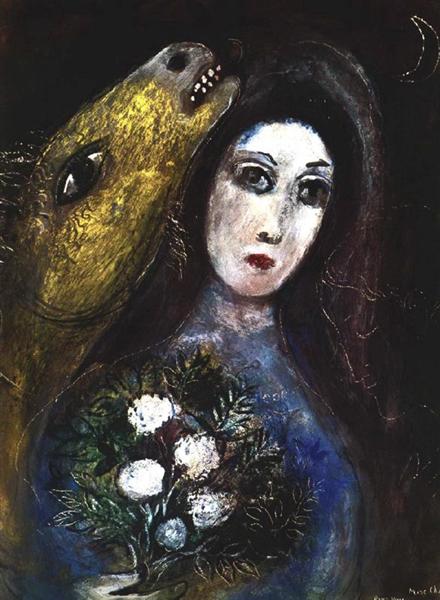
Oil on Canvas
The body of works shows a period of 42 years in Chagall's life, from the age of 28 to 70. The first painting is from the year he married Bella, and the last painting seems to close the love story between them, in the expression of mourning for her death. In this painting, "The Street Performers" (1957), dim figures are shown emerging from the black substrate, holding musical instruments with a melancholy look that is felt in their hollow eyes. Quiet and slow music is felt through the load of color in many layers, with short engravings to partially characterize the contours of the figures. There are five white spots of color (the faces of two figures, the violin divided in two and the figure's hand), with one of them partly bluish (painting 10), similar to the five white spots of color that represent the flowers the figure is holding in painting 9. This painting is perceived as a requiem for Bella's memory.

Marc, Chagall. The Street Performers. 1957.
Oil on Canvas
Comparing this last painting to the first painting, it seems that an optimistic world invites them, the world is depicted as cruel and scary. From a fairly realistic and accurate painting, his paintings became surreal and expressive. However, along the way it seems that Chagall kept the same shades of colors, which he used in different ways to express his experiences in his works; "History is revealed on canvas, in a spectacle of colors" (Chagall, 1951, pp. 71-72).
Connecting the creative process and autobiography to the ETC model in art therapy. In the works of Marc Chagall, you can see a connection to the elements of the Expressive Therapies Continuum (ETC) model, which explains the way in which the creator processes information during the interaction with the art materials, through four levels of information processing, when the division is arbitrary, and in fact they often exist at the same time, when they cannot be separated . Each level in the ETC ranges between two poles, between right brain function and left brain function (Hinz, 2015). The main functions of the left lobe are involved in analytical and continuous processes, while the right lobe works in a spatial, parallel and synchronous manner (Lusebrink, 2004). In this section, I will present the way in which the four levels of information processing are manifested from the phenomenological and symbolic observation of Chagall's works.
Chagall used a wide variety of materials, but in the body of works selected for this work, most of the works were done in oil paints on canvas with the mediation of a brush, with the exception of one work in the medium of gouache (drawing 9). These two substances belong to the wet substances, which allow renewed developmental regulation (Harpaz, 2007). In addition to this, working with these materials involves repetitive actions, for example dipping the brush in turpentine and oil, taking paint from a palette and wiping with a cloth. This kind of ritual is for the creator an anchor for finding an inner rhythm and from that for a deeper emotional work (Orbach and Galkin, 1997).
His first works are characterized by a delicate layer of paint, partly transparent and mostly opaque, by applying color and blurring it, together with short and precise movements, which create clear and continuous lines. In this way of creation, it is possible for the creator to feel grounded and in control of the body, which express the first level of the ETC, movement and feeling (Hinz, 2015). His later works are characterized by faster movements, spreading paint with the edges of the brush, applying raw paint in many layers and engravings that reveal the substrate. What is possible in this way of using substances, at this level of the ETC, is expressions of one's deep feelings and the ability to re-evaluate them (Hinz, 2015).
The processing of information at the second level ranges from emotional expression to perceptual expression, which are made possible through the use of formal elements (Hinz, 2015). In most of his early works, a balanced composition can be found thanks to the acceptance of colored elements in the creative space. Also, the use of complementary colors, with the color defining the shape. All these allow the creator to identify his feelings safely. In addition, the presentation of his self-portrait in the third person in his works, enables internal and external organization and regulation through the ability to observe from the side (Hinz, 2015). In painting 3, in which Chagall does not appear in person, the figures are depicted with clearer outlines than the description of the images in his other works from the same period. Defining the boundaries of the form enables the definition of the experience, and thus a sense of control over the experience for the creator (Hinz, 2015). His later works become darker and the images lose their clear form, which gives a sense of difficulty in containing the hard feelings for the creator. Alongside this, it seems that the color black is used as a basis on which the emotional expressions can be carried, together with the use of engraving, which can express the release of these emotions.
At the cognitive-symbolic level, there is a complex processing of information, which enables inner growth from finding personal meaning through understanding symbols and universal values (Hinz, 2015). Through the use of symbolic representations, Chagall describes his partnership with Bella, at the beginning of their journey, in an intimate and unified way, together with the amplification of the greatness and beauty of nature. As you can see in picture 2, their heads one above the other create an upward aspiration and even create an association of a tree trunk. In his landscape, the trees seem to unite with each other and even grow in demand for a relationship. The pair of red fruits and the very presence of the dinnerware in the private space of the interior of the house seem to not only express the existential need and the necessary means in our lives, but also emphasize their partnership as a spiritual source that nourishes their soul as food for the body. In addition, a pair of plates one on top of the other, with the upper one inverted and closing above the lower one, strengthen the partnership and give it a sense of unification into a single unit.
In his later paintings, against the background of the war, in the forced transitions to more protected countries, Chagall presents many images scattered across the creative space. In painting 6 and painting 7, you can find images from his memories of his life in his native land (Mulan, 1969). The creation of this sort of collage, in the way the images are selected and arranged in the compositional space, creates a personal meaning for the creator, which stimulates cognitive processes and develops the ability to organize and function higher (Hinz, 2015). Chagall wrote that "my colors were turning blue with terror" (1951, p. 37), which could be a symbolic image through the color in its personal meaning for him, in the representation of Bella's figure together with him, floating in a blue space, in painting 8, after her death. Painting 10, the last in the body of works, shows figures in masks, which can express a symbolic self-portrait, and thus be a parallel to the parts that the creator ignored in the past, which allows him to live with ambivalence and ambiguity in his life, thus finding meaning out of difficulty and pain (Hinz, 2015).
The connection of the symbolic content from the processing of the visual and sensory information, creates a change in the brain operations of the creator. Furthermore, the creation processes and the products, enable the creation of a renewed engagement system implicitly (Hass-Cohen, 2016). Within a safe relational space, regulated sensory experience, authentic emotional expression and activation of past memories are possible (Czamanski-Cohen & Weihs, 2016). It seems that Chagall was able to overcome the death of his lover Bella and formed a new relationship; "My worries disappear one by one when Eve is with me" (Mulan, 1969, p. 72). In light of his writings and the changes that took place in the development of his artistic expression, it seems that Chagall was able to develop insights, create integration and move between all the levels according to the ETC, which express the creative level in the ETC model (Hinz, 2015).
Summary. The artist Marc Chagall created at a time when modern art flourished. Together with all the visual elements from the different art styles, Chagall expressed through colors and images, emotional content and his perception of life. From the observation of his hundreds of works and focusing on a selected body of works in this work, it is felt that for Chagall, art was a central place in his life, where he could express his feelings and through it contain his experiences, in relation to the events of his personal life and also in relation to the harsh reality that befell most of humanity during this period of war.
The changes that took place in Chagall's creative processes reflect the process of his mental development. In his youth, his paintings are executed with a precise hand, in one clear and bright layer, together with a more calculated organization of the compositional space. Chagall wrote his autobiography, when he was 35 years old, expressing in his words an authentic and honest connection with himself. It seems that the world is presented open to him, as is also felt in his early paintings as an optimistic world that invites him together with his wife Bella. His later paintings, began to be filled with many different images, accumulated different and darker layers of colors. In his adult life, Chagall experienced separation from his homeland and his first wife, his life accumulated different chapters in his story, which are reflected in the different layers of his paintings. Later, an engraving was added, revealing the original color of the substrate under the many layers of paint. Chagall wrote a poem about the homeland in his heart, which is his only homeland (the poem is written at the end of the post). Despite the tragedies in his life, he seems to have managed to maintain an inner connection with his authentic self.
Although much was said in our classroom about the importance of reflective writing from experience, the importance of the words sharpened for me, from creating the connection between the phenomenological analysis, and Chagall's writings and words, quoted by others, to theories in the field of art therapy. The words, connected to the colors, the shapes and the relationships between them, can create a sequence into a more comprehensible story of the artist's life.
From my acquaintance with the works of Marc Chagall, we chose to filter out works that contain Jewish images and scenes from the Bible and the New Testament, because I did not want to get into the religious issue, as Chagall also clarified on this subject: "I am a mystic. I don't go to synagogue or church. My creativity is my prayer" (Mulan, 1969, p. 178).
By creating a timeline with significant points in Chagall's life, the relationship between him and Bella, his first wife, stood out. It is also possible that our choice of marital relationship between the two is influenced by our family relationship with Bella, who is a cousin of our paternal grandfather, Alexander Cherkov. We found a connection to ourselves in everything related to the focus of love, which establishes the beneficial force for the creation of life; "If I create from my heart - everything comes out beautifully, and if from my mind - nothing comes out" (Mulan, 1969, p. 122).
A poem by Marc Chagall
"My only homeland
She is the homeland in my heart,
I come to her without a passport
As if she were home.
She sees my sadness
and my loneliness,
And she gives me sleep.
There were days when I had two heads,
There were days when there were two pence
covered with a veil of love
and melt in the scent of a rose.
But now he showed as if even in my withdrawal
I'm always moving forward
towards a raised gate,
beyond which stretch walls,
behind which sleep extinguishes the thunder
and the resulting shine.
My only homeland
She is the homeland in my heart" (Mulan, 1969, p. 85).
bibliography
Orbach, N. and Galkin, L. (1997). The spirit of the material: treatment in art - moves and experiences. Kiryat Bialik: "Ach" publishing house.
Harpaz, R. (2007). Art therapy in a neuro-cognitive aspect. Ndla from https://www.hebpsy.net/me_article.asp?id=74&article=1439
Molen, R. M. (1969). Chagall's world (D. Eliram, translator). Tel Aviv: Stimatsky Publishing House.
Chagall, M. (1951). My life (M. Levin, translator). Tel Aviv: Poalim Library.
Betansky, MG (1995). What Do You See? Phenomenology of Therapeutic Art Expression. London: Jessica Kingsley Publishers.
Chagall, M. (1915). Window in the Country [Oil on canvas]. Retrieved from https://www.wikiart.org/en/marc-chagall/all-works#!#filterName:all-paintings-chronologically,resultType:masonry
Chagall, M. (1915). The Birthday [Oil on canvas]. Retrieved from https://www.wikiart.org/en/marc-chagall/all-works#!#filterName:all-paintings-chronologically,resultType:masonry
Chagall, M. (1916). Bella and Ida by the Window [Oil on canvas]. Retrieved from https://www.wikiart.org/en/marc-chagall/all-works#!#filterName:all-paintings-chronologically,resultType:masonry
Chagall, M. (1917). Bella with White Collar [Oil on canvas]. Retrieved from https://www.wikiart.org/en/marc-chagall/all-works#!#filterName:all-paintings-chronologically,resultType:masonry
Chagall, M. (1918). The Promeneade [Oil on canvas]. Retrieved from https://www.wikiart.org/en/marc-chagall/all-works#!#filterName:all-paintings-chronologically,resultType:masonry
Chagall, M. (1932). Bride with Blue Face [Oil on canvas]. Retrieved from https://www.wikiart.org/en/marc-chagall/all-works#!#filterName:all-paintings-chronologically,resultType:masonry
Chagall, M. (1938-43). Hour between Wolf and Dog (Between Darkness and Light) [Oil on canvas]. Retrieved from https://www.wikiart.org/en/marc-chagall/all-works#!#filterName:all-paintings-chronologically,resultType:masonry
Chagall, M. (1947). Bouquet with flying lovers [Oil on canvas]. Retrieved from https://www.wikiart.org/en/marc-chagall/all-works#!#filterName:all-paintings-chronologically,resultType:masonry
Chagall, M. (1955). For Vave [Gouache]. Retrieved from https://www.wikiart.org/en/marc-chagall/all-works#!#filterName:all-paintings-chronologically,resultType:masonry
Chagall, M. (1957). The Street Performers [Oil on canvas]. Retrieved from https://www.wikiart.org/en/marc-chagall/all-works#!#filterName:all-paintings-chronologically,resultType:masonry
Czamanski-Cohen, J. & Weihs, KL (2016) The Bodymind Model: A platform for the conduct of the mechanistic study of art therapy. The Arts in Psychotherapy. 51. 63-71
Hass-Cohen, N., & Clyde Findlay, J. (2016). Art Therapy Relational Neuroscience. In J. Rubin (Ed). Approaches to Art Therapy - Theory & Techniques. London & New York: Routledge.
Hinz, LD (2015). Expressive Therapies Continuum: Use and Value Demonstrated With Case Studies. Canadian Art Therapy Association Journal, 28. 1-2, 43-50.
Lusebrink, VB (2004). Art Therapy and the Brain: An Attempt to Understand the Underlying Processes of Art Expression in Therapy. Art Therapy: Journal of the American Art Therapy Association. 21 (3). 125-135.
Sherway Academy Arts & Sciences (2017, November, 30). Chagall Documentary [Video File]. Retrieved from https://www.youtube.com/watch?v=dzuhgF9EqDw
Wolff, J. (2019). Marc Chagall Artist Overview and Analysis. Retrieved from: https://www.theartstory.org/artist-chagall-marc-life-and-legacy.htm

